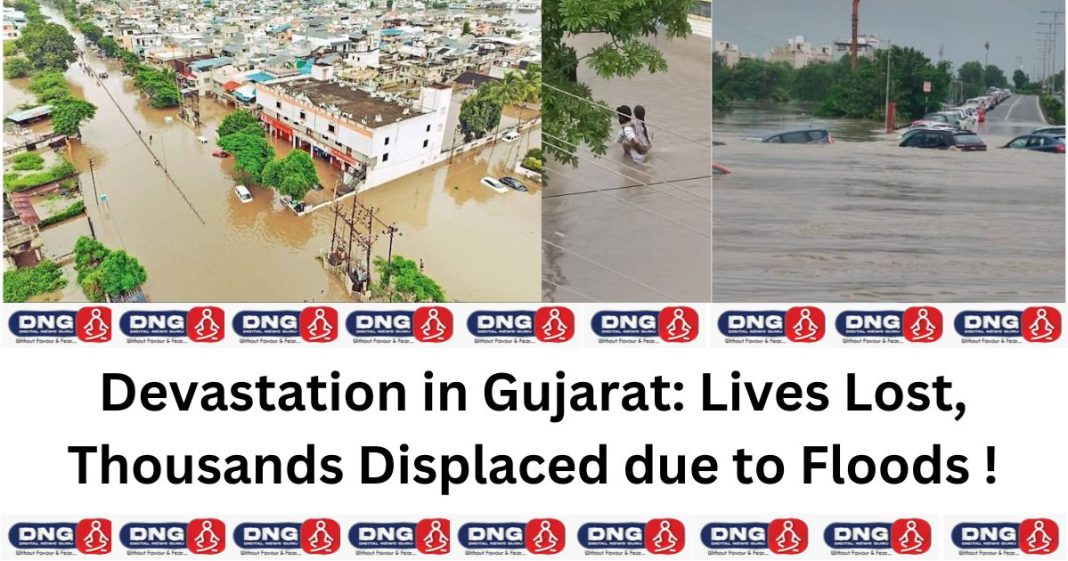DIGITAL NEWS GURU NATIONAL DESK :-
Devastation in Gujarat: Lives Lost, Thousands Displaced due to Floods !

In late August 2024, Gujarat, a state in western India, faced one of its worst natural disasters in recent years. Heavy and incessant rainfall led to devastating floods, resulting in widespread destruction, loss of life, and displacement of thousands of people. The floods, which began on August 26, have claimed at least 16 lives so far and have affected thousands of others, as waterlogged areas and overflowing rivers continue to wreak havoc across the state.
The Scale of the Disaster:
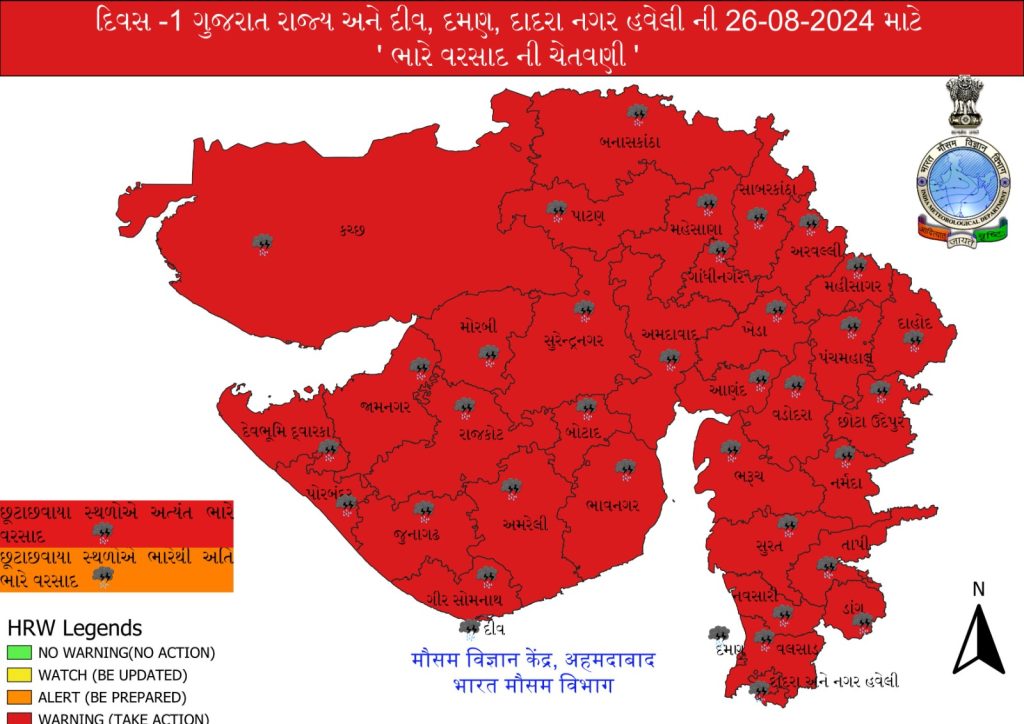
The intensity of the rainfall caught many by surprise. In just 48 hours, several districts in Gujarat received rainfall that exceeded the average for the entire monsoon season. The state’s metrological department reported that regions such as Saurashtra and South Gujarat were particularly hard-hit, with many areas recording over 500 mm of rainfall within a day. Rivers like the Narmada, Tapi, and Sabarmati swelled beyond their banks, leading to flash floods in numerous towns and villages.
Urban areas, including major cities like Ahmedabad, Surat, and Rajkot, were not spared. Streets turned into rivers, submerging vehicles and inundating homes, shops, and public infrastructure. In Ahmedabad, several low-lying areas were completely submerged, forcing residents to evacuate their homes. The situation was similarly dire in Surat, where the Tapi River’s water levels rose alarmingly, prompting the local administration to issue red alerts and commence large-scale evacuations.
Human Impact: Lives Lost and Displaced:

The human toll of the Gujarat floods has been significant. As of August 28, the death toll stands at 16, with many more injured or missing. Rescue operations, led by the National Disaster Response Force (NDRF), the Indian Army, and local authorities, have been ongoing, but the sheer scale of the disaster has made it difficult to reach all affected areas promptly. In rural regions, where infrastructure is less robust, many communities have been cut off, with roads and bridges washed away by the relentless floodwaters.
The floods have also led to a large-scale displacement of people. Over 8,500 individuals have been evacuated from their homes, with many taking refuge in temporary shelters set up by the government and non-governmental organizations. In these shelters, basic necessities like food, water, and medical aid are being provided, but the overcrowded conditions have raised concerns about the spread of waterborne diseases and other health issues.
The psychological impact on the affected populations has been severe as well. Many of those displaced have lost their homes, possessions, and, in some cases, loved ones. The trauma of the sudden and violent displacement, coupled with the uncertainty of when they will be able to return home, has left many in a state of despair. The state government has announced compensation for those who have lost family members or property, but the road to recovery will be long and challenging.
Economic Consequences: A Heavy Toll on Agriculture and Infrastructure:
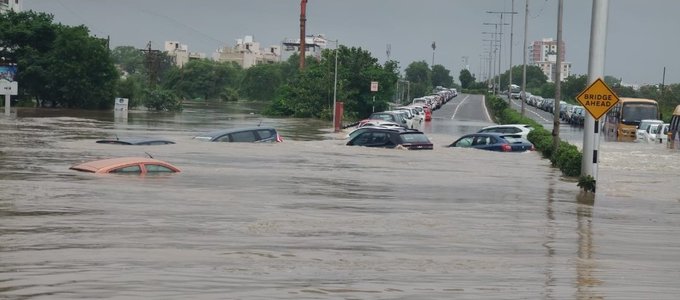
The floods have not only taken a human toll but have also inflicted severe damage on Gujarat’s economy. Agriculture, which is the backbone of the state’s rural economy, has been particularly hard hit. Vast swathes of farmland, especially in the fertile plains of Saurashtra and South Gujarat, have been submerged, leading to the destruction of standing crops. Farmers who were already struggling with fluctuating market prices and input costs now face the prospect of complete crop failure, which could push many into financial ruin.
In addition to agriculture, the floods have caused extensive damage to infrastructure. Roads, bridges, and public utilities have been washed away or severely damaged, disrupting transport and communication across the state. Power outages have been reported in several districts, and water supply systems in urban and rural areas have been compromised, raising concerns about access to clean drinking water.
The industrial sector, too, has not been spared. Gujarat, known for its robust industrial base, particularly in the cities of Ahmedabad, Surat, and Vadodara, has seen factories and warehouses flooded, leading to significant losses in production and inventory. The full economic impact of the floods will take time to assess, but early estimates suggest that the cost of rebuilding could run into thousands of crores.
Government Response: Relief Efforts and Challenges:
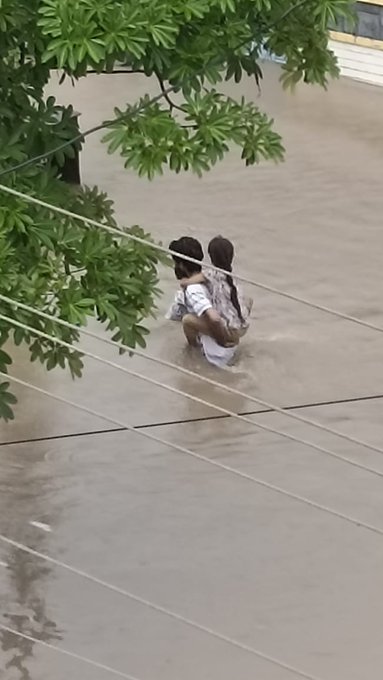
The Gujarat state government, along with the central government, has mobilized significant resources to respond to the crisis. Chief Minister Bhupendra Patel has been on the ground, coordinating relief efforts and visiting affected areas. The state government has announced an initial relief package to provide financial assistance to the victims and has promised to rebuild the damaged infrastructure as quickly as possible.
Rescue operations have been the immediate priority, with the NDRF deploying multiple teams to the worst-hit areas. Helicopters have been used to airlift stranded individuals, and boats have been deployed to reach those trapped in remote villages. However, the scale of the disaster has posed significant logistical challenges, with many areas still inaccessible due to the floodwaters.
In addition to rescue and relief operations, the government has been focused on preventing the outbreak of diseases, which is a common consequence of flooding. Medical teams have been dispatched to affected areas to provide vaccinations and treatment for waterborne diseases. Efforts are also being made to restore clean water supplies and sanitation facilities to prevent the spread of illness in the temporary shelters.
Looking Ahead: The Path to Recovery:
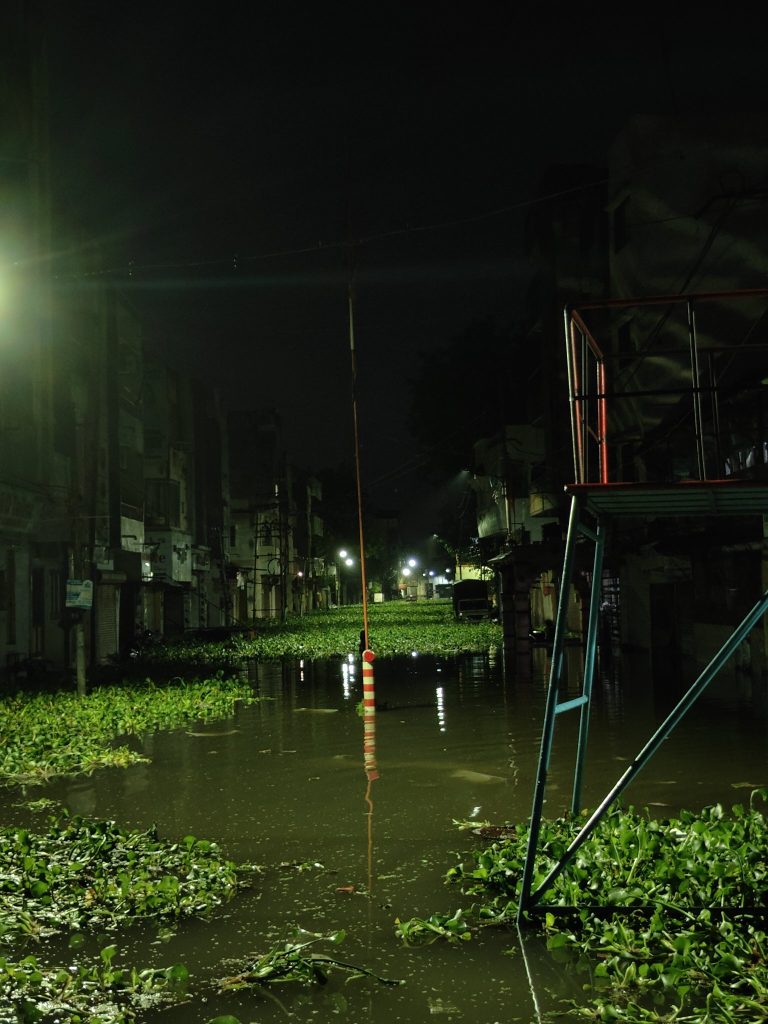
As the floodwaters begin to recede, the focus will shift from rescue operations to recovery and rebuilding. The challenges ahead are immense. Reconstructing homes, restoring infrastructure, and reviving the agricultural sector will require significant financial resources and coordinated efforts from both the government and private sector.
The floods in Gujarat have underscored the urgent need for better disaster preparedness and resilient infrastructure, particularly in the face of increasingly unpredictable weather patterns due to climate change. In the coming months, as the state begins to rebuild, there will also be a need for a broader discussion on how to mitigate the impact of such disasters in the future.
For now, the people of Gujarat are left to pick up the pieces of their lives and begin the long journey toward recovery. The road ahead is uncertain, but the resilience and determination of the state’s people will undoubtedly play a crucial role in overcoming this crisis.
YOU MAY ALSO READ :- Deepak Tijori birthday special: 90 के दशक मे अपने अभिनय से सभी दर्शकों के दिलों मे किया है खूब राज, साइड हीरो के रोल में भी जान डाल देते थे दीपक !



